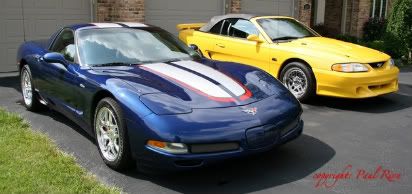Note: 94-95 specific changes are in red
1.) Remove push on connector from starter solenoid and turn ignition switch on. Place car in neutral or Park and set the parking brake. Remove the coil wire from distributor & and hold it 3/8” away from the engine block. Jumper the screw to the big bolt on the starter solenoid that has the battery wire connected to it. You should get a nice fat blue spark.
Most of the items are electrical in nature, so a test light, or even better, a voltmeter, is helpful to be sure they have power to them.
No spark, possible failed items in order of their probability:
A.) MSD or Crane ignition box if so equipped
B.) Coil
C.) TFI module
D.) PIP sensor in distributor. See paragraph 3A - a noid light will tell if the pip is working by flashing when the engine is cranking.
E.) No ECC or computer power - ECC or computer relay failure
86-93 models only: ECC relay next to computer - look for 12 volts at the fuel injector red wires
94-95 models only: EEC or PCM power relay in the constant control relay module. Look for 12 volts at the fuel injector red wires.
F.) No ECC or computer power - fuse or fuse link failure
86-93 models only: Fuse links in wiring harness - look for 12 volts at the fuel injector red wires. All the fuse links live in a bundle up near the starter solenoid.
94-95 models only: 20 amp EEC fuse in the engine compartment fuse box. Look for 12 volts at the fuel injector red wires.
G.) Ignition switch - look for 12 volts at the ignition coil red/lt green wire.
H.) Computer
See the following links for wiring diagrams...
http://www.autozone.com/servlet/UiBr...3d8016713c.jsp for 79-88 model cars
Computer/fuel pump/ignition wiring diagram, 86 model http://www.autozone.com/images/cds/g...3d80167158.gif
Computer/fuel pump/ignition wiring diagram, 87 model http://www.autozone.com/images/cds/g...3d8016715e.gif
Computer/fuel pump/ignition wiring diagram, 88 model http://www.autozone.com/images/cds/g...3d80167162.gif
http://www.autozone.com/servlet/UiBr...3d8019595a.jsp for 89-93 model cars
Computer/fuel pump/ignition wiring diagram, 89-90 cars http://www.autozone.com/images/cds/g...3d8019595f.gif
Computer/fuel pump/ignition wiring diagram, 91-93 cars
http://www.autozone.com/images/cds/g...3d80195960.gif
http://<font color="Red">http://www...db3c.jsp</font> for 94-98 model cars
2.) Spark at coil wire, pull #1 plug wire off at the spark plug and check to see spark. No spark, possible failed items in order of their probability:
A.) Moisture inside distributor – remove cap, dry off & spray with WD40
B.) Distributor cap
C.) Rotor
D.) Spark Plug wires
E.) Coil weak or intermittent - you should see 3/8" fat blue spark with a good coil
3.) Spark at spark plug, but no start.
Next, get a can of starting fluid (ether) from your local auto parts store: costs a $1.30 or so. Then pull the air duct off at the throttle body elbow, open the throttle, and spray the ether in it. Reconnect the air duct and try to start the car. Do not try to start the car without reconnecting the air duct.
Two reasons:
1.) If it backfires, the chance for a serious fire is increased.
2.) On Mass Air cars, the computer needs to measure the MAF flow once the engine starts.
If it starts then, you have a fuel management issue. Continue the checklist with emphasis of fuel related items that follow. If it doesn’t, then it is a computer or timing issue: see Step 4.
Clue – listen for the fuel pump to prime when you first turn the ignition switch on. It should run for 5-20 seconds and shut off. To trick the fuel pump into running, find the ECC test connector and jump the connector in the Upper RH corner to ground.
If the relay & inertia switch are OK, you will have power to the pump. Check fuel pressure – remove the cap from the schrader valve behind the alternator and depress the core. Fuel should squirt out, catch it in a rag. Beware of fire hazard when you do this. In pinch you can use a tire pressure gauge to measure the fuel pressure. It may not be completely accurate, but you will have some clue as to how much pressure you have.
No fuel pressure, possible failed items in order of their probability:
A.) Tripped inertia switch – Coupe & hatch cars hide it under the plastic trim covering the driver's side taillight. Use the voltmeter or test light to make sure you have power to both sides of the switch
B.) Fuel pump power relay – located under the driver’s seat in most stangs built before 92. On 92 and later model cars it is located below the Mass Air Flow meter. Look for 12 volts at the Pink/Black wire on the fuel pump relay.
C.) Clogged fuel filter
D.) Failed fuel pump
E.) 86-93 models only: Blown fuse link in wiring harness. Look for 12 volts at the Orange/Lt Blue wire on the fuel pump relay. The fuse links live in the wiring harness near the starter solenoid.
94-95 models only: 20 amp fuel pump fuse in the engine compartment fuse box. Look for 12 volts at the Dark green/yellow wire on the constant control relay module.
F.) Fuel pressure regulator failed. Remove the vacuum line from the regulator and inspect for fuel escaping while the pump is running.
Fuel pressure OK, the injectors are not firing.
A.) A Noid light available from Autozone, is one way to test the injector wiring.
B.) I like to use an old injector with compressed air applied to the injector where the fuel rail would normally connect. I hook the whole thing up, apply compressed air to the injector and stick it in a paper cup of soapy water. When the engine cranks with the ignition switch on, if the injector fires, it makes bubbles. Cheap if you have the stuff laying around, and works good too.
a.) Pull an injector wire connector off and look for 12 volts on the red wire when the ignition switch is on.
b.) No power, then look for problems with the 10 pin connecter (salt & pepper shakers at the rear of the upper manifold).
c.) No power and the 10 pin connections are good: look for broken wiring between the orange/black wire on the ECC relay and the red wire for the 10 pin connectors.
4.) Spark & fuel pressure OK.
A.) Failed IAB (no airflow to start engine). Press the throttle ¼ way down and try to start the car.
B.) Failed computer (not very likely)
C.) Engine ignition or cam timing off: only likely if the engine has been worked on recently).
D.) Firing order off: HO & 351 use a different firing order from the non HO engines.
HO & 351W 1-3-7-2-6-5-4-8
Non HO 1-5-4-2-6-3-7-8
E.) No start when hot - Press the throttle to the floor & try starting it if you get this far. If it starts, replace the ECT.





 Reply With Quote
Reply With Quote







Bookmarks